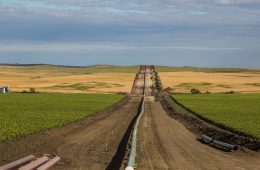![]()

A 3-judge panel of the 8th U-S Circuit Court of Appeals has upheld a federal judge’s 2021 decision dismissing a 2016 lawsuit filed by protesters of the Dakota Access Pipeline alleging law enforcement officers used excessive force during a clash in 2016.
The 9 protesters alleged in the lawsuit that their civil and constitutional rights were violated by the officers using tear gas, rubber bullets, shotgun bean bags and water in below-freezing temperatures on Nov. 20, 2016, at a blocked highway bridge.
The defendants included the Morton and Stutsman County sheriffs, the Mandan police chief and 100 unidentified officers, but federal District Judge Daniel Traynor granted a defense motion to dismiss the case. The protesters appealed last year.
After the appeals court decision affirming the ruling came Nov. 3, defense attorney Randall Bakke told The Bismarck Tribune that “the defendants are pleased” while the lawyer for the protesters described it as “disappointing.
Attorney Rachel Lederman called the case “a hard-fought struggle by Indigenous-led water protectors to vindicate their constitutional rights, which were so egregiously violated” at the protest.
Ledermain said “It is disappointing to see the federal courts readily absolve law enforcement who brutally pummeled nonviolent, peaceful people with freezing high pressure water and dangerous, maiming munitions for hours on end.”
Similar lawsuits continue to play out, including cases filed by 3 protesters who say they were injured because of officers’ actions, and by 2 photographers who allege excessive force and violations of their constitutional rights while covering the protest.
The U-S Army Corps of Engineers recently released a draft environmental review of the Dakota Access pipeline’s controversial crossing under the Missouri River near the Standing Rock Reservation. A decision is expected late next year.
The pipeline began operating in 2017 and has remained so during the latest environmental review. The Standing Rock Sioux Tribe opposes the pipeline as a risk to its drinking water supply due to the potential of a spill.
